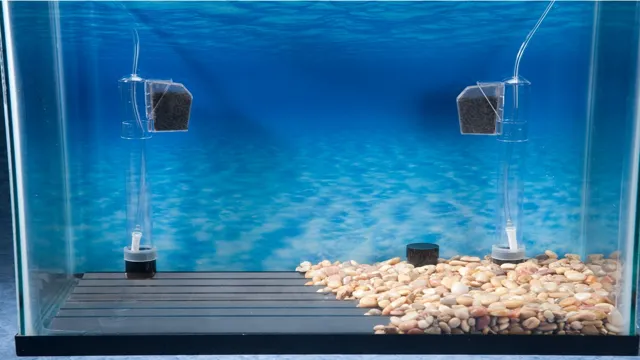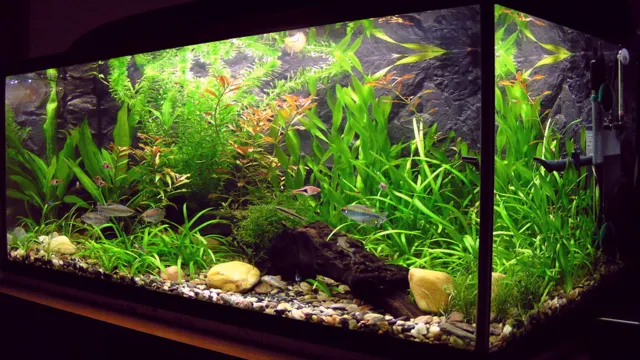How to Make a Lid for an Aquarium for Rats: Step-by-Step Guide for a Safe and Secure Rat Habitat

Are you a proud owner of pet rats? Do you want to provide your little furry friends with a comfortable and safe living environment? If you do, then you know how important it is to have a secure lid on your rat’s aquarium. Rats are curious and agile creatures that can easily escape if their enclosure is not properly secured. That’s why in this guide, we will show you how to make a lid for an aquarium for your rats – a DIY project that’s both affordable and practical.
With our step-by-step instructions, you can customize a lid that will fit your aquarium perfectly and protect your rats from any harm. So, let’s get creative and build a safe and comfy home for your beloved rats!
Materials Needed
If you have a pet rat living in an aquarium, it’s important to create a lid for their safety and security. The good news is that making a lid for an aquarium for rats is easy and requires minimal materials. You’ll need a piece of wire mesh or hardware cloth, a pair of wire cutters, and some zip ties.
First, measure the size of your aquarium and cut the mesh to fit on top, leaving a little extra on the sides to wrap around the edges. Next, use the zip ties to secure the mesh to the edges of the aquarium. Make sure to trim any excess zip ties so they don’t pose a hazard to your pet.
With your new lid in place, your rat can safely explore their environment without the risk of escaping or injury. So why not give it a try today? Your rat will thank you for it!
– Aquarium lid frame
If you’re into aquariums, then you know that a lid frame is essential. A lid frame is an important part of keeping your aquarium safe and secure. You don’t want any fish jumping out or pets getting in.
To create an aquarium lid frame, you’ll need a few materials. First, you’ll need a sturdy frame material, like wood or PVC. Next, you’ll need a mesh or screen material to secure the frame.
You can choose from fiberglass, aluminum, or stainless steel. Finally, you’ll need some tools like a saw, drill, and screws to construct the frame. Building an aquarium lid frame can be a fun and easy DIY project, and it’ll keep your pets safe and secure.
Plus, it’ll look great in your aquarium setup.

– Wire mesh
When it comes to creating a sturdy fence or boundary, wire mesh is an excellent choice for both residential and commercial properties. But what materials do you need when working with wire mesh? Firstly, you’ll need to consider the gauge, or thickness, of the wire you’ll be using. Thicker gauges are stronger and more durable, but also require more effort to cut and manipulate.
Next, you’ll need to determine the size and shape of the mesh itself. Generally, smaller holes provide more security while larger holes allow for better visibility. Finally, you’ll need tools for cutting and shaping the wire, such as pliers and wire cutters, as well as posts or brackets to hold the mesh in place.
By considering these factors, you’ll be able to choose the right materials for your wire mesh project and create a strong, reliable barrier for your property. So whether you’re looking to create a privacy fence or secure your business’s perimeter, wire mesh is a versatile and effective option.
– Screws and nuts
When it comes to screws and nuts, there are a few materials that you’ll commonly see, each with their own benefits and drawbacks. The first and most common is steel, which is durable and strong but can rust over time if not properly treated. Stainless steel is also a popular choice, as it resists rust and is ideal for use in wet or humid environments.
Brass is another option, which not only looks great but also resists corrosion and is easy to work with. Finally, there’s nylon, which is lightweight and resistant to chemicals, making it perfect for use in industries like electronics. Whatever material you choose, it’s important to make sure that it’s of high quality to ensure that your screws and nuts last for a long time.
– Pliers and wire cutters
For any DIY projects or repairs, having a good pair of pliers and wire cutters is essential. These tools come in various shapes and sizes, so it’s important to choose the right one for the job. Pliers are used for gripping, twisting, and bending wires and other materials, while wire cutters are used to snip and trim wires to the desired length.
Look for pliers with a comfortable grip that won’t slip out of your hands and wire cutters with sharp blades that can handle different types of wires. Whether you’re working on a plumbing project, electrical repair, or crafting, having pliers and wire cutters in your toolkit makes the job so much easier. Don’t forget to clean and store them properly after use to prolong their lifespan.
With the right tools in hand, you’ll be able to tackle any DIY project with ease and confidence.
Step-by-Step Guide
If you own rats and want to ensure that they are safe in their aquarium, it’s essential to have a lid covering the top. Fortunately, making a lid for your aquarium is a relatively easy process. Firstly, take precise measurements of your aquarium’s top, including its length and width, so you can accurately cut a piece of wire mesh.
After cutting the wire mesh to size, bend the edges over using pliers, so there are no sharp edges that could harm your rats. Secure the mesh to the top of your aquarium using glue or clips, making sure that the lid is securely in place. Voila! Your rats are now safe from any harm that could come their way.
By following these steps, you can quickly and easily provide a safe and secure environment for your small furry friends.
1. Measure and cut the wire mesh to the size of the aquarium
When it comes to creating a wire mesh cover for your aquarium, the first step is to measure and cut the mesh to the appropriate size. This process may seem straightforward, but it’s crucial to get it right for the cover to fit snugly and effectively keep your fish safe. Start by measuring the length and width of your aquarium, both inside and out.
Use these measurements to determine the size of the wire mesh you’ll need. Be sure to choose a wire mesh with small enough openings to prevent any fish from accidentally getting through. Once you have your wire mesh and dimensions, carefully cut the mesh to fit the size of your aquarium top.
It may be helpful to use a wire cutter or tin snips to ensure clean, precise cuts. Take your time with this step to avoid any mistakes, as it will be the foundation for the rest of your wire mesh cover project. With this fundamental step complete, you’re on your way to creating a custom wire mesh cover that will protect and enhance your aquarium.
2. Attach the wire mesh to the lid frame using screws and nuts
To continue building your homemade chicken coop, the next step is to attach the wire mesh to the lid frame using screws and nuts. This process will ensure that your chickens are protected from predators and won’t fly the coop. To begin, make sure you have the right tools handy, including a drill, screws, nuts, and wire mesh.
Next, lay the wire mesh over the top of the lid frame and use the drill to secure it in place. Make sure to use screws and nuts that are the appropriate size to keep the mesh taut and secure. It’s also important to make sure that there are no gaps or holes in the mesh that could allow predators to enter.
By taking these simple steps, you can ensure that your chickens stay safe and secure in their new coop.
3. Trim any excess mesh using wire cutters
“wire cutters” Now that you’ve secured the mesh to your fence frame, it’s time to get rid of any excess wire using your trusty wire cutters. This step is crucial to ensure that your fence looks clean and uniform, and it prevents loose wires from potentially injuring anyone or snagging on clothing. Take your time and maneuver the cutters carefully around the mesh, identifying any protruding wires and snipping them as flush to the frame as possible.
Depending on your fence’s shape and size, this step can take a while to complete, but it’ll be worth it for the neat and streamlined result. Don’t forget to dispose of any stray wires properly and keep a close eye on the cutters’ blades to avoid accidents. With the excess mesh gone, you’re one step closer to having a finished product that’ll impress your neighbors and provide a sturdy and safe barrier for your property.
4. Check that the lid fits snugly on top of the aquarium
When setting up your aquarium, it’s essential to ensure that the lid fits securely on top. This step is crucial in protecting your fish and ensuring they don’t jump out of the tank. Start by checking the edges of the lid to make sure they are not damaged or warped.
Next, place the lid on top of the aquarium and gently press down. If there are any gaps or spaces between the lid and tank, your fish may be able to escape, and debris may enter the water. To avoid this, you can use foam strips or silicone to seal any openings.
Another option is to invest in a custom lid that fits perfectly on your tank. In any case, taking the time to properly secure your aquarium lid is vital for the safety and well-being of your underwater pets.
Tips and Tricks
If you’re a rat owner, you know the importance of having a secure lid for your pet’s aquarium. Rats have a tendency to be curious and escape artists, so a lid is a necessary precaution. Fortunately, making a lid for your rat’s aquarium is a fairly easy process.
First, measure the length and width of the aquarium and cut a piece of mesh wire to match. Place the wire over the top of the tank and secure it in place using zip ties. Make sure to cut off any excess zip tie ends to prevent injury to your rats.
Additionally, you can add a layer of fabric or cardboard underneath the mesh wire to provide a more comfortable surface for your rats to climb on. When creating the lid, be sure to leave an opening large enough for you to easily access the aquarium for cleaning and feeding. With these simple steps, you can make a secure lid for your rat’s aquarium, providing safety and peace of mind for both you and your furry friends.
– Use pliers and gloves when cutting and handling wire mesh
When it comes to working with wire mesh, it’s important to take some safety precautions to avoid getting injured. One of the best tips we can give you is to always use pliers and gloves when cutting and handling wire mesh. These tools will give you a better grip and help prevent any injuries that may occur while working with wire mesh.
Pliers can help you cut through the wire mesh more easily and quickly, and gloves can protect your hands from cuts and scratches. Additionally, you can use gloves made from thicker materials such as leather for added protection. When cutting wire mesh, make sure that you’re using sharp wire cutters that can easily cut through the metal.
By taking these small steps to protect yourself, you can avoid any potential injuries while working with wire mesh and make your work much easier.
– Double check measurements before cutting to avoid mistakes
When it comes to woodworking, it’s always better to err on the side of caution. Double-checking your measurements before making a cut can make all the difference between a perfect piece and a ruined project! The last thing you want is to discover that your measurements are off after you’ve already made a cut. It’s a frustrating setback that can be easily avoided.
So take the time to measure twice before making any cuts. This simple step will save you time, money, and frustration in the long run. Trust us – it’s worth it! By following this tip, you’ll be well on your way to becoming a skilled woodworker.
Conclusion
In conclusion, creating a lid for your aquarium turned rat haven doesn’t have to be a daunting task. With a few simple steps and some creative thinking, you can construct a lid that not only keeps your furry friends safe and secure but also adds a touch of style to their habitat. So go ahead and get those gears turning, because the sky’s the limit when it comes to designing the perfect rat-proof lid!”
FAQs
What materials can I use to make a lid for an aquarium for rats?
You can use wire mesh, plexiglass, or plastic grids to make a safe and secure lid for your rat’s aquarium.
How do I secure the lid to the aquarium to ensure my rats cannot escape?
Use screws or clips to securely attach the lid onto the aquarium. Make sure there are no gaps or loose edges where your rats can chew through or escape.
Can I use a wooden lid for my rat’s aquarium?
It is not recommended to use a wooden lid for your rat’s aquarium since rats are natural chewers and can easily chew through the wood, leading to escape or injury.
Is it necessary to have a lid for my rat’s aquarium?
Yes, it is essential to have a lid for your rat’s aquarium to prevent your rats from escaping, and to keep them safe from other pets or household hazards.
How do I make sure my lid has proper ventilation for my rats?
Add small air holes or use wire mesh to create a breathable lid for your rat’s aquarium. Make sure the holes are small enough to prevent your rats from escaping.
What is the ideal size for a lid for my rat’s aquarium?
The size of the lid should match the size of the aquarium, ensuring that there are no gaps or loose edges.
Can I purchase a pre-made lid for my rat’s aquarium?
Yes, pre-made lids are available at pet stores or online retailers. However, it is always best to check the measurements before purchasing to ensure a proper fit for your rat’s aquarium.






